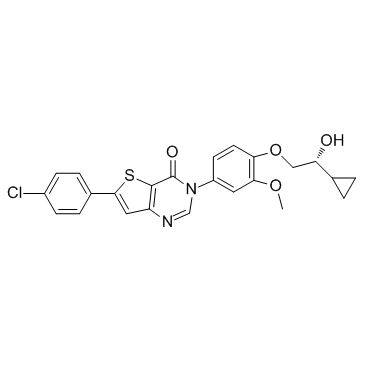1197420-05-5
| Name | BMS-819881 |
|---|---|
| Synonyms |
6-(4-Chlorophenyl)-3-{4-[(2R)-2-cyclopropyl-2-hydroxyethoxy]-3-methoxyphenyl}thieno[3,2-d]pyrimidin-4(3H)-one
Thieno[3,2-d]pyrimidin-4(3H)-one, 6-(4-chlorophenyl)-3-[4-[(2R)-2-cyclopropyl-2-hydroxyethoxy]-3-methoxyphenyl]- |
| Description | BMS-819881 is a melaninconcentrating hormone receptor 1 (MCHR1) antagonist, which binds rat MCHR1 with a Ki of 7 nM. BMS-819881 also is selective and potent for CYP3A4 activity with an EC50 of 13 μM. |
|---|---|
| Related Catalog | |
| Target |
rat MCHR1:7 nM (Ki) CYP3A4:13 μM (EC50) |
| In Vitro | BMS-819881 (Compound 27) is 99.8% binds to rat serum proteins and rat MCHR1 Ki is 7 nM. FLIPR-based assays establish that BMS-819881 is a potent and highly selective MCHR1 functional antagonist. BMS-819881 (Kb=32 nM) effectively blocks MCH stimulated Ca2+ mobilization in heterologous cells overexpressing MCHR1 but fails to inhibit MCH mediated Ca2+ mobilization of cells expressing MCHR2 at 10 μM. No activity is observed upon screening BMS-819881 at 10 μM versus a panel of 20 GPCRs associated with feeding homeostasis. The percent of BMS-819881 binds to serum proteins is species dependent ranging from 99.8%, 99.6%, and 99.3%, respectively, for rat, dog, and monkey. When BMS-819881 is screened for cytochrome P450 (CYP) activity, EC50 values for CYP1A2, CYP2C9, CYP2C19, CYP2D6 are >40 μM; however, the CYP3A4 EC50 is 13 μM[1]. |
| In Vivo | BMS-819881 has moderate terminal elimination half-life (t1/2=5.7 h, 32±8 h, and 14±3 h for rat (1 mg/kg, iv), dog (1 mg/kg, iv), and cynomologous monkey (1 mg/kg, iv))[1]. |
| Kinase Assay | Membranes from stably transfected HEK-293 cells expressing a mutated (E4Q, A5T) hMCHR1 receptor are prepared and differential centrifugation. Binding experiments are carried out with 0.5-1.0 μg of membrane protein incubated in a total of 0.2 mL in 25 mM HEPES (pH 7.4) with 10 mM MgCl2, 2 mM EGTA, and 0.1% BSA (binding buffer) for 90 min. For competition binding assays, reactions are carried out in the presence of 0.06–0.1 nM [Phe13, [125I]Tyr19]MCH and increasing concentrations of unlabeled test molecules. Reactions are terminated by rapid vacuum filtration over 96-well GFC Unifilter plates precoated with 0.075 mL of binding buffer containing 1% BSA and washed 3 times with 0.4 mL of PBS (pH 7.4) containing 0.01% TX-100. Filters are dried, 0.05 mL of MicroScint 20 is added to each well, and radioactivity is subsequently quantified by scintillation counting on a TopCount microplate scintillation counter. Inhibitory constants are determined by nonlinear least-squares analysis using a four-parameter logistic equation[1]. |
| Cell Assay | Stable HEK-293 cells expressing human MCHR1 or MCHR2 receptor are plated at a density of 50 000 cells/well in 96-well polylysine coated plates and cultured overnight in DMEM (high glucose (4.5 g/mL), 25 mM HEPES, pH 7.4, 10% fetal bovine serum, 1 mM NaCl) at 37°C, 5% CO2 conditions. For assay, the medium is replaced with 90 mL per well dye solution consisting of 3.8 mM Fluo4 AM, 0.04% Pluronic F-127, and 2.5 mM Probencid in base buffer (Hank’s balanced salt solution, 25 mM HEPES, 0.1% BSA). Dye solution is allowed to “load” for 1 h at room temperature in subdued light. Dye is subsequently removed and replaced with 75 mL of base buffer and 75 mL of diluted test compound (e.g., BMS-819881; 10 μM) and incubated for an additional 15 min. Test compound dilution plates are prepared by serial diluting test and reference compounds from 100% DMSO stocks first 1:50 in base buffer and then serially (1:3.26) in base buffer containing 2% DMSO to generate 12 half log test concentrations[1]. |
| Animal Admin | Rats, Dogs, and Cynomologous monkeys [1] PK studies using three species (rat, dog, and cynomologous monkey) are conducted with BMS-819881 administered iv at 1 mg/kg[1]. |
| References |
| Density | 1.5±0.1 g/cm3 |
|---|---|
| Boiling Point | 697.7±65.0 °C at 760 mmHg |
| Molecular Formula | C24H21ClN2O4S |
| Molecular Weight | 468.953 |
| Flash Point | 375.8±34.3 °C |
| Exact Mass | 468.091064 |
| LogP | 3.95 |
| Vapour Pressure | 0.0±2.3 mmHg at 25°C |
| Index of Refraction | 1.698 |
| Storage condition | 2-8℃ |
